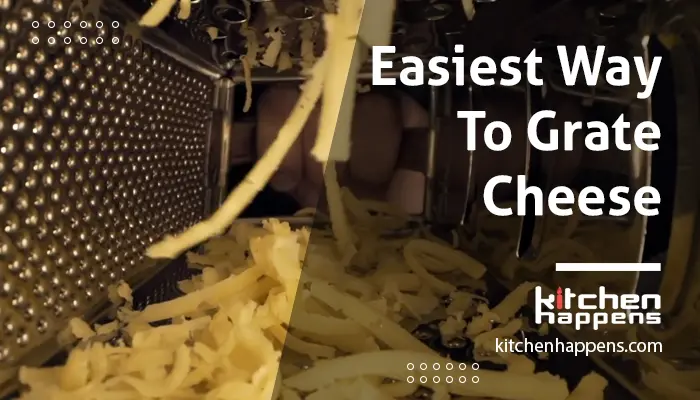Cheese is a form of happiness!
Whether it’s a pizza, pasta, or other recipes, it becomes 100 times awesome with overloaded cheese. Well, I am not saying that every recipe needs cheese, but those that call for it have to be cheesy enough for you to go like, Yummyyyyy!
But, to make those delicacies, you must know how to grate cheese, right?
Well, that’s why we have arranged this whole writing to teach you not only the easiest way to grate cheese but also why you should grate the cheese yourself instead of buying pre-shredded ones, what tools you can use, some professional tips to make your task more manageable, and so on.
So, let’s begin our cheesy journey from here.
Should You Buy Shredded Cheese from Store Or Gate on Your Own?
When your recipe requires grated cheese, you may think that buying shredded cheese is more convenient than doing this by yourself.
But what if I say that it is far better to grate your cheese by hand. Okay, be prepared to get surprised by the reasons!
1. Melts Smoothly
Pre-grated cheese has preservatives like natamycin and potato starch to prevent the cheese shreds from forming clumps in the bag. This is the reason why pre-shredded cheese doesn’t melt well while cooking.
On the other hand, freshly grated cheese doesn’t contain those additives. And that’s why your melted cheese will be much smoother and less clumpy.

2. Tastes Better
Your food will taste fresher and creamier because freshly grated cheese doesn’t have additional preservatives and additives, and also you are shredding it right away.
And I think you will agree that fewer additives are always a healthier alternative.
3. Budget Friendly
Whether you are on a budget or want to get the most for your money, an 8 oz cheese block is a far better option than an 8 oz bag of pre-grated cheese since it produces more grated shreds.
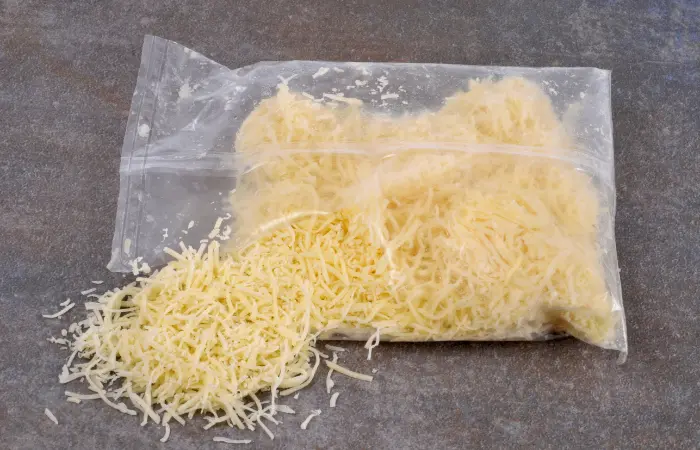
Also, keep in mind that you are paying more for convenience when purchasing pre-grated cheese.
Alright, now that you know which option is better, it’s time to focus on our main concern: learning the easy ways to grate cheese.
What Is The Easiest Way to Grate Cheese?
The most common and correct way to grate cheese is obviously using a cheese grater. There are typically two types of cheese graters that are the most popular.
The medium-sized teeth are excellent for garnishing tacos.
So, let’s talk about them.
1. Using A Box Grater
A box grater has four sides with different-sized teeth. You can choose from those four sides depending on what type of shred you want.
The medium-sized teeth are excellent for garnishing tacos. Use the smaller holes for finely grated cheese in recipes that call for grated parmesan or garnishing pasta dishes. The easiest way to grate mozzarella cheese is by grating with larger holes. And for hard cheese, the smaller holes are best.

The tiniest holes produce the finest cheese grates. Choose this option if you wish to make the pre-grated hard cheese (like cheese dust) that is typically found in plastic tubs or cardboard cans at the grocery store.
Anyway, here is the procedure to follow to grate cheese with a box grater.
Step 1
Take a medium to large-sized cheese. If you take a small piece of cheese, then there is a possibility of scraping your fingers. So, avoid cutting the cheese in small portions and instead work with a medium or a larger piece.
Step 2
Spray some cooking spray on the outside of the grater plate that you will be using. This will help the cheese glide quickly.
Step 3
How you will use your grater depends on what type it is. For example, if your grater has a handle, place it over a cutting board. And for the grater without a handle, hold it over a bowl.
There is also a box cheese grater with container available. If you have that, simply attach the container, and you are good to go.
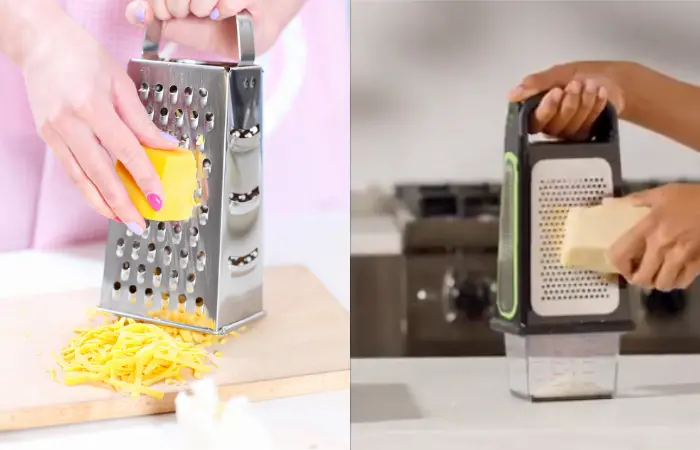
Step 4
Now, rub the cheese against the holes of the grater in an up-and-down motion. Once the piece of cheese becomes smaller, rub it with your palm so you don’t scrape your knuckles.
2. Rotary Cheese Grater
Not everyone is comfortable with a box grater. Some find it hard to glide the cheese and also fear cutting themselves. In such cases, using a rotary cheese grater is one of the best options.
A rotary grater has a handle attached to a circular grating compartment. The cheese is then grated by rotating a side crank.
Rotary graters work excellently with hard cheese. Therefore, if you are looking for an option for the easiest way to grate parmesan cheese and pecorino romano, you may go for it.
Okay, now look at the method of the grating.
Step 1
First, cut your cheese according to the size of your grater’s compartment to fit there. Now, raise the top handle, place a small block of cheese, and lower the handle.
Step 2
Place a plate or bowl nearby the aiming position of the grater. With your thumb, apply slight pressure to the handle’s top. Take a regular grip on the handle with your other fingers.

Step 3
Start turning the handle and stop when you have grated the whole piece or as much as you want.
A rotary grater is not only a safe option for your hands but also very efficient. Also, this is actually the right way to grate cheese in large quantities rather than using a box grater which will take more hard work and time.
Hence, I will suggest you use a rotary grater if you need to make nacho dips or breakfast casseroles.
Now, the only downside of a hand-held cheese grater is that if your recipe requires a lot of grated cheese, you may get exhausted by the grating. In that instance, you may consider an electric cheese grater.
3. Using An Electric Cheese Grater
Using an electric cheese grater is indeed the quickest way to grate cheese. With a push of a button, you can grate, shred, slice, and chop your cheese as they come with different attachments.
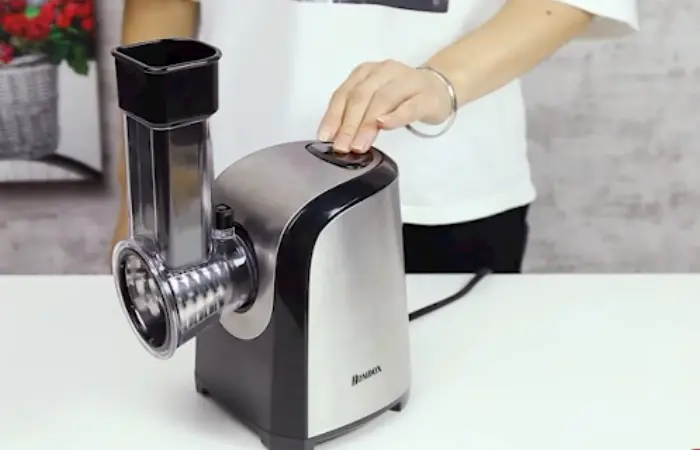
It’s also easy to use.
Step 1
First, attach the shredding blades of your need. Place a bowl at the aiming point of the machine.
Step 2
Turn on the machine, and put a block of cheese inside the feed tube. Push the cheese with the help of the food pusher.

That’s it. You will be left with finely grated cheese as much as you want. Although the other two grating tools work great with every type of cheese, using an electric grater is the easiest way to grate hard cheese without getting hand cramps.
You can get a small compact electric cheese grater for as low as $35. If you prefer a countertop device that is more functional and can do more than just grating cheese, it might cost closer to $100. And for the commercial electric cheese grater suitable for restaurants, canteen, and shops will cost hundreds of dollars.
Now, what will happen if you have none of these three types of graters? Then, a question arises, is there a way to grate cheese without a grater?
To find the answer, you need to go through my next segment.
Other Best Way to Grate Cheese Without A Grater
If you don’t have a cheese grater, there is no way to be worried. Some simple tools are available in your kitchen that can help you out.
So, let’s take a look at those tools and how to use them.
Option 1: Use A Food Processor
A food processor is the most effective yet easy way to grate cheese. To be honest, this is actually my favorite way too. This versatile kitchen tool can save you time.
The best part is that it works with both harder and softer cheeses and everything in between.
Here is how to grate cheese with the help of a food processor.
Step 1
First, you need to attach the shredding disc of your food processor. Every food processor typically comes with two shredding options (fine and medium). So, take according to your requirement.
The shredding disc of a food processor has the same cutouts as a box cheese grater. If you are confused about which one is the shredding disc, go to the owner’s manual for details about your particular model.
Install the drive shaft to the processor’s center work bowl, and then attach the disc. It will be connected to the top instead of the bottom. Next, close the lid.
Step 2
Make sure the cheese is straight out of the refrigerator because it should be hard and fairly cold. When shredding soft cheese, such as mozzarella, place it in the freezer for 15 to 20 minutes. Remember that the cheese will clump together if it is too warm or soft.
Then divide the cheese into the largest pieces that will still fit through the processor’s feed tube. Moreover, remove the rind if you don’t want to consume it.
Step 3
Put the cheese slice into the lid’s feed tube. Turn on the processor and push down the cheese slice with a pusher. The cheese block will quickly transform into gorgeously shredded cheese.
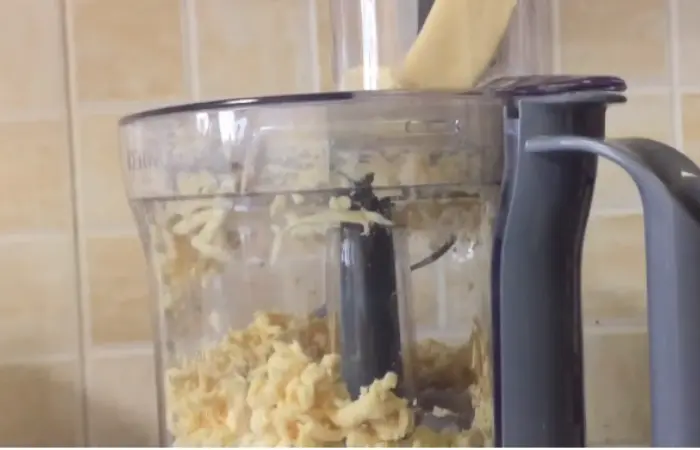
In case you don’t have a food processor, you may opt for a blender that works like a food processor. Various blenders come with a food processor combo. However, if your blender doesn’t have that, you still have other options that I will describe now.
Option 2: Utilization of A Zester
You can use a lemon zester to grate your cheese. This method is suitable for hard cheese like parmesan cheese.
Zest the cheese, similarly to what you do with the lemon or orange. Make sure to be careful when the piece of cheese becomes smaller. Your cheese will become powder-like in consistency, making it ideal for topping rich Italian meals like risotto.
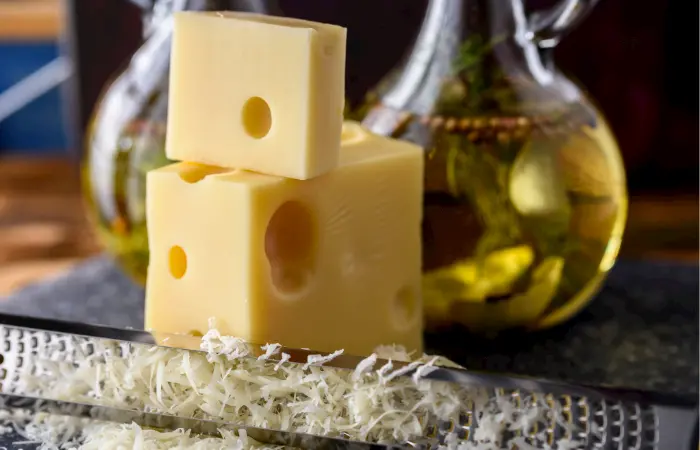
Option 3: Take Advantage of Your Vegetable Peeler
Another effective way of grating cheese without a grater is by utilizing a vegetable peeler. If you have a cheese slicer, that would be even better. But vegetable peelers can still do the job.
Make sure the blade of your vegetable peeler is clean and sharp.
Peel the cheese block from the corner. Another option is to slice the cheese block lengthwise, then chop the resulting cheese strips into fine shreds.

Option 4: Vegetable Chopper Works Too!
You may not expect it, but a vegetable chopper can actually work as an excellent cheese grater. Surely it works best on semi-hard and softer cheese like cheddar and mozzarella.
However, if your chopper is sturdy, you may also try shredding hard, cured cheeses.
Now, follow the below steps and learn how to shred cheese with a vegetable chopper.
Step 1
Chop the block of cheese into small pieces that will fit into your vegetable chopper. Choose the plates for your chopper; I advise selecting a plate that has a grater-like cutting hole.
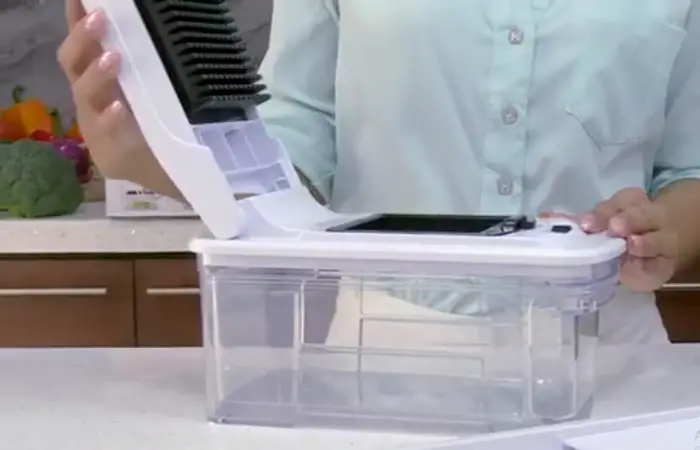
Step 2
Next, place the chunks of cheese in the chopper and press the chopping lid down on it. You might need to repeat this procedure several times at various angles, depending on the plate you selected, but you will have your shredded cheese shortly.
Option 5: Use A Mandoline
You can use a mandolin to shred firm cheese.
Install the grater attachment on the mandoline. Set the mandolin on a strong cutting board, place the cheese on top of it, and secure it with the guard that comes with the mandolin.
Glide the cheese down until most of it is grated. Repeat grating as much as you want.

Option 6: A Knife Can Be Your Last Savior
If you don’t have either of the other tools that I talk about, there is no need to be upset. You still have this option. Just make sure your knife is sufficiently sharp to create the perfect shred-like consistency.
First, take a cold cheese block and put it on a cutting board. Ensure the cutting board doesn’t slip or move on the counter. Then, chop the cheese block into little pieces using your sharp knife. Finally, cut those thin cheese slices into smaller cheese strips.

Finally, we are done talking about all the alternatives of a grater to shred cheese. Now, there are some important tips that I would like to share with you.
Pro Tips to Keep in Mind While Grating Cheese
Using any of the methods of grating cheese will surely give you grated cheese without much trouble. But some tricks can make your task even easier.
Here, I include three hacks that you should try while grating next time.
Choose The Right Type of Cheese for Grating
Half of the issue gets resolved when you know which type of cheese you should pick to grate. Some cheeses do not shred well. For instance, soft, mushy cheeses (like fresh mozzarella and camembert) won’t provide excellent shreds. They either have too much fat or water for them to shred easily.
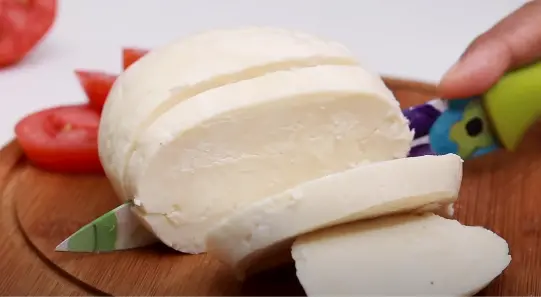
Of course, you can still grate them, but it would be better if you simply sliced them and added them to your meal. On the other hand, cured, semi-hard, or hard cheeses are perfect for shredding and grating.
Freeze The Semi-Hard And Soft Cheese Before Grating
In the previous section, I said that it’s better to slice soft cheese. But not every meal calls for a sliced texture. Then what to do to achieve the grated consistency.
Well, here is your answer. If you wanna grate softer cheese rather than the harder ones, make sure to leave it in the freezer for around 30 minutes before grating. The cheese will get firmer, making it easy for you to grate.
Additionally, soft cheese can clog your kitchen tool. But that won’t happen once you make it firm by freezing.
Grease The Blades Before Shredding
Did you struggle in the past while grating cheese, as it constantly stuck everywhere?
All you need to do is grease your blades to solve this problem!
To stop cheese shreds from sticking to your knife or grating disk, spray it with cooking spray. Don’t use it much. Just make sure the cutting surfaces are evenly coated, and that’s it!
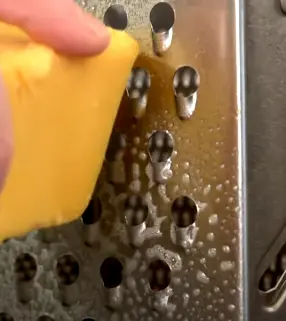
Alright, now tell me, have you ever found yourself left with extra shredded cheese and didn’t even know how to store them?
As cheese is pretty expensive, you don’t want to waste it or let it rot. So, knowing the right way to store them is extremely important.
Therefore, check my next segment and learn the best way to store grated cheese.
How to Store Grated Cheese? The Right & Best Way
You can store grated cheese in a plastic bag or airtight container. If your cheese has a package that is resealable, you can store it in that bag. If not, you can take a sealable plastic bag. Just be sure to squeeze out all of the air from the bag before closing it. Then, put the bag in the freezer. This method is best for hard cheese.
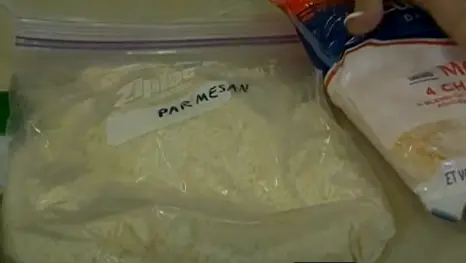
But for soft cheese, the shreds start clumping like mozzarella because of the moisture. So, you need to add something to prevent clumping.
The most popular thing to add to your shredded mozzarella cheese is cellulose. It functions by absorbing water from the cheese’s wetness. If you don’t have cellulose, it’s okay! There is a substitute for it which is cornstarch.
Cornstarch is a common ingredient in the kitchen and will do the same job as cellulose. So, here is what you need to do.
Add some cornstarch to your grated cheese. 1 to 2 teaspoons are enough for one block of cheese. You just need to lightly coat the shreds. To ensure equal covering, shake the cheese and cornstarch mixture. And lastly, place the cheese in an airtight freezer-safe container and put it in the freezer.
Don’t worry about the taste of the shredded cheese as you add cornstarch. Since you use such a little amount, it won’t affect the taste of the cheese at all.
You can store grated cheese in the freezer for up to 2 months. After that, it will start to lose quality.
Best Way to Clean A Cheese Grater
The longer you wait to clean your cheese grater, the more the cheese residue will harden to the tool’s surface. And, of course, you don’t want this mess to happen. However, if you take a minute to wash your cheese grater quickly as you finish using it, you can easily cut your cleaning time in half.
So, here are two easy and best ways to clean your grater.
1. Cleaning in The Dishwasher
A dishwasher is indeed a great bet if you have one. Just make sure that your grater is dishwasher-safe before you toss it inside.
When washing cheese graters, skipping the dry cycle is a great idea because it might bake on any leftover residue. Instead, take out those residual pieces as you use a microfiber cloth to dry up your grater.
Now, if you don’t have a dishwasher, my following cleaning method is for you.
2. Cleaning with Lemon
Lemon is a great natural grease cutter. Their acidity can cut the grease, and their mushy pulp helps scrub metal and reach those difficult-to-reach holes.
To start with the cleaning process, you will need the following:
- A lemon that has been cut in half
- 2 to 3 tablespoons of salt
- A small bowl
- Dishwashing solutions
- And a microfiber towel
Directions
1. Pour the salt into the bowl. Dip the lemon’s cut end into the salt.
2. Use the salted lemon to scrub the grater. Leave this to sit for 3-5 minutes.
3. Wash the cheese grater in boiling water to remove any last traces of lemon juice or residue.
4. Next, Clean the grater the same way you would clean dishes: with dishwashing liquid, water, and a microfiber cloth. To avoid damaging your fingertips, wipe the grater in the opposite direction of the grating or in the direction of the blades.
If you don’t have lemon available, you can substitute a potato for the above procedure.
After learning different ways to grate cheese, how to store it, and how to clean your grater, how about we explore some excellent food that is made with grated cheese?
So, be prepared to have a watery mouth!
Easy Things to Make with Grated Cheese
Various dishes are made with grated cheese. Here are a few that are quite simple to make.
Grilled Cheese Sandwich
Since cheese and bread slices are rarely the same size or shape, a grilled cheese sandwich is either utterly devoid of bread or has cheese pouring out the edges.
So, the next time you make a grilled cheese sandwich, use grated cheese to cover every square inch of a slice of bread, regardless of size or shape.
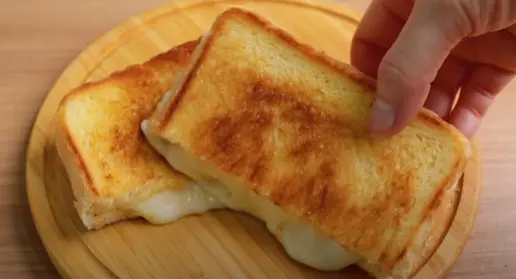
Cheese Sauce
Using grated cheese is best when you want to make cheese sauce for nachos or fondue simpler. Grated cheese melts more quickly and evenly, preventing clumps in the cheese sauce.
Baked Potato with Cheese Stuffed
The next time you bake potatoes, make sure to stuff them with shredded cheddar cheese. You may look into this cheesy stuffed baked potato recipe if you don’t know how to do it.
Finally, we are done with today’s topic, so let’s wrap it up here.
Final Words
Hopefully, this guide on the easiest way to grate cheese was a great help to you. Next time you will grate cheese, make sure to follow all the tips that I have provided.
Lastly, thanks for staying till the end.
Frequently Asked Question
What’s the difference between shredded and grated cheese?
Shredded and grated cheese has a few differences. The way they look is one difference. What they are utilized for is another difference. While some cheeses are better to shred, some are better to grate.
Compared to shredded cheese, grated cheese has smaller chunks. Grated cheese is likely for sprinkling over food. While on the other hand, shredded cheese is easier to pick up as it resembles pieces of cheese more.

